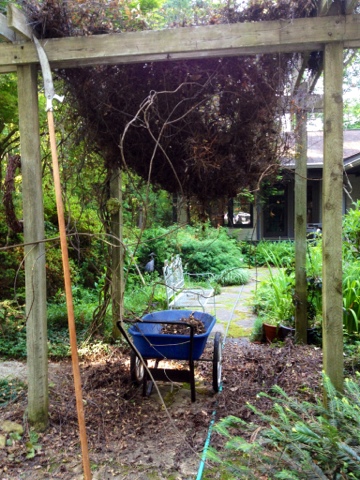When you come across something for the garden so 'magical' that you know it will give you an instant lift every time you look at it there is nothing to do but find a home for it in the garden where you pass buy it every day. This glass bird bath when lit by the sun is a welcoming beacon from very far away. I see it from the top of my driveway, a distance of 200'.
It and two beautifully planted pots from Garden Supply Company in Apex, NC were just what a sad entry bed needed to perk up the picture for the rest of the summer. I will see this every day coming in and out of the house in different light conditions throughout the day.
The 18" diameter pots were stuffed with Coleus, Variegated Carex, Dusty Miller, Dwarf Elephant Ear, Begona, and Variegated Phlox. They have made great companions to a large 2' diameter pot with a central conifer growing out in preparation for planting in the garden come fall.
I have other edges to my largely green populated woodland that I like to add some sort of concentrated color for the summer. I like to start plants small, usually in 4""-6" pots and compose tiny colorful gardens in larger pots. Many of them have woody stems... shrubs and trees. Because I volunteer on the Master Planning Committee at the JC Raulston Arboretum in Raleigh, NC, I am on the list to receive 8 free plants from their excellent propagation efforts each year. They, too, are small and have to be babied for a couple of years in my decorative 'nursery' pots. The turquoise trio were purchased from The Garden Hut in Fuquay Varina, NC.
Right now I'm growing out small Hostas, Japanese Maples, Boxwood and a special Ginko. The Hostas are from Green Hill Farm. The Maples and Ginko come from Mr. Maple and Mr. Ginko. All three are specialty mail order nurseries in NC.
I inherited this amazing wire chair from a dear friend and have the seat planted in an upended rectangular plastic garbage can lid. The Dwarf Cryptomeria along with Japanese Roof Iris, a tracery of 'Gold Heart' Ivy and annual Caladium and Euphorbia sit well together in this unique remembrance chair. The Cryptomeria has survived two cold winters in 3" of soil conditioner and will be planted in the garden in autumn.
My containers are close to the house and a hose. Easy to water and say hello to each of them. It's also close to my supply of Osmocote, a slow release fertilizer applied twice through the summer. Remember plants in containers need all the help they can get to stay beautiful. Take a tip from commercial establishments that care for containers. Foliar feed every 2-3 weeks when watering to keep the annual plants blooming and beautiful through the growing season.
Don't forget that sculptural bits of color can add a lot to your garden edges in the woodland where it might be difficult to grow or water a pot.
This coiled copper snail floats above a collection of three empty containers shaped like olive jars.
I enjoy a number of 'stop the eye' pieces as I move along my woodland paths.
And today when I arrived home my new Elephant Ear was waving HELLO!






















































